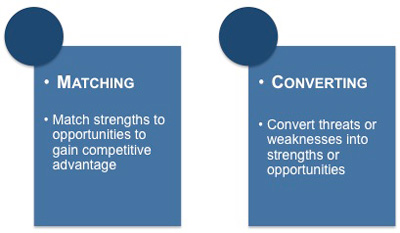Matching and Converting

There are two simple methods, referred to as 'matching' and 'converting,' that organizations can utilize when applying the results of the SWOT analysis to strategy decisions.
 |
Matching uses competitive advantage to pair strengths with opportunities. For example,
In the 1980s UK clothing retailer Marks and Spencer had a strong presence in the high street and a customer base that bought on the basis of quality rather than price. M&S were able to leverage these strengths to exploit the opportunity to sell high-quality food and beverages to its customers. The company began by selling pre-prepared sandwiches and snacks that were made from higher-quality ingredients than its competitors were using. This focus on quality was unique at the time and enabled M&S to corner the market until its competitors began to copy the formula. Thirty years later M&S is still a major player in the UK quality food and beverage market and these items account for a substantial portion of its total profits.
Converting means converting weaknesses or threats to strengths or opportunities. For example,
Many island-based Scottish whisky distilleries are unable to expand their production facilities because of environmental or logistical issues. This weakness can be converted into a strength by stressing the artisan nature of the product and making the limited production synonymous with exclusivity. This means that they can maintain high retail prices and reasonable profits even when losing market share to industrial scale producers.
Whilst these techniques can be useful, they do need to be put into perspective. In the first example, it would have been far from obvious that selling quality sandwiches represented an opportunity for a clothing retailer with no experience in that sector. In addition, there was no shortage of established competitors, albeit not selling the type of sandwiches that M&S chose to offer its customers.
The point is that even if a SWOT analysis is used to highlight opportunities that 'match' the organization's strengths, the best option may be far from obvious. Whoever suggested that M&S begin retailing food probably had quite a struggle to get the idea taken seriously because even though this undoubtedly represented an opportunity, there would have been many other more obvious opportunities available.
In the second example, converting can amount to little more than making a virtue out of a necessity. The small whisky distilleries simply cannot increase production to any significant degree and their marketing strategy is arguably an inevitable result of this, rather than one option chosen from several other possibilities.
Matching and converting are useful ways of looking at the output from the SWOT analysis but both require a lot of debate and analysis rather than instant answers.
|
|
 |
You may also be interested in: Definition of SWOT Analysis, Strengths, Weaknesses, Opportunities, and Threats, Internal Factors (Strengths and Weaknesses), External Factors (Opportunities and Threats), Matching and Converting, Advantages and Disadvantages and SWOT Analysis Example.


